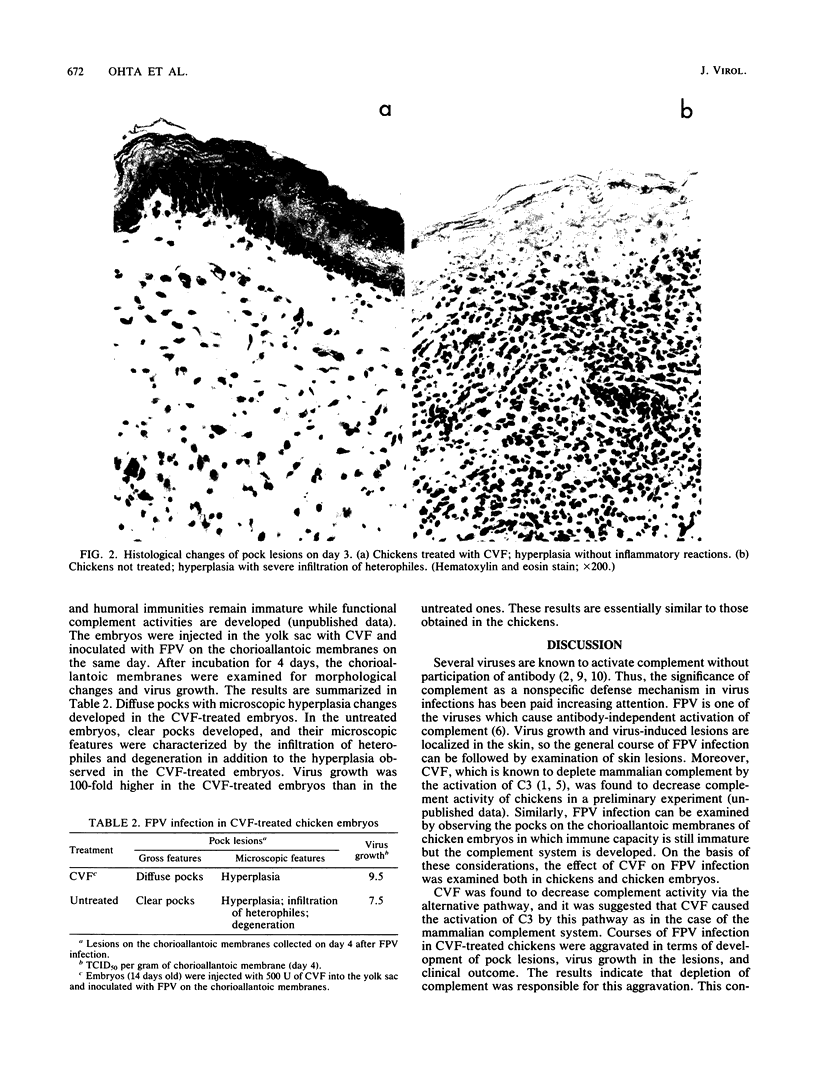Abstract
The course of infection with an attenuated strain of fowlpox virus (FPV), which is known to induce antibody-independent activation of complement via the alternative pathway, was investigated in 1- to 3-day-old chickens and 14-day-old chicken embryos by treatment with cobra venom factor (CVF). CVF was found to inhibit complement activity transiently via the alternative pathway but not via the classical pathway. In chickens treated with CVF, virus growth in the skin was enhanced, and pock lesions tended to disseminate, leading to fatal infection in some birds. Histologically, an acute inflammation at an early stage of infection (within 3 days) was inhibited, and virus content in the pock lesion was increased. In chicken embryos with immature immune capacities, CVF treatment caused changes in pock morphology from clear pocks to diffuse ones, an increase in virus content in the pock, and inhibition of cell infiltration. Thus, FPV infection was aggravated in both CVF-treated chickens and chicken embryos. These results are discussed in relation to roles of complement in the elimination of virus at an early stage of FPV infection.
Full text
PDF



Images in this article
Selected References
These references are in PubMed. This may not be the complete list of references from this article.
- Cochrane C. G., Müller-Eberhard H. J., Aikin B. S. Depletion of plasma complement in vivo by a protein of cobra venom: its effect on various immunologic reactions. J Immunol. 1970 Jul;105(1):55–69. [PubMed] [Google Scholar]
- Hirsch R. L. The complement system: its importance in the host response to viral infection. Microbiol Rev. 1982 Mar;46(1):71–85. doi: 10.1128/mr.46.1.71-85.1982. [DOI] [PMC free article] [PubMed] [Google Scholar]
- Hugli T. E., Müller-Eberhard H. J. Anaphylatoxins: C3a and C5a. Adv Immunol. 1978;26:1–53. doi: 10.1016/s0065-2776(08)60228-x. [DOI] [PubMed] [Google Scholar]
- Lachmann P. J., Halbwachs L., Gewurz A., Gewurz H. Purification of cobra venom factor from phospholipase A contaminant. Immunology. 1976 Dec;31(6):961–968. [PMC free article] [PubMed] [Google Scholar]
- Nelson R. A., Jr A new concept of immunosuppression in hypersensitivity reactions and in transplantation immunity. Surv Ophthalmol. 1966 Aug;11(4):498–505. [PubMed] [Google Scholar]
- Ohta H., Kai C., Yoshikawa Y., Yamanouchi K. Activation of chicken alternative complement pathway by fowlpox virus-infected cells. Infect Immun. 1983 Nov;42(2):721–727. doi: 10.1128/iai.42.2.721-727.1983. [DOI] [PMC free article] [PubMed] [Google Scholar]
- Okada H., Baba T. Rosette formation of human erythrocytes on cultured cells of tumour origin and activation of complement by cell membrane. Nature. 1974 Apr 5;248(448):521–522. doi: 10.1038/248521a0. [DOI] [PubMed] [Google Scholar]
- Okada N., Shibuta H., Okada H. Activation of the alternative pathway of guinea pig complement by Sendai virus-treated cells. Microbiol Immunol. 1979;23(7):689–692. doi: 10.1111/j.1348-0421.1979.tb00511.x. [DOI] [PubMed] [Google Scholar]
- Sissons J. G., Oldstone M. B., Schreiber R. D. Antibody-independent activation of the alternative complement pathway by measles virus-infected cells. Proc Natl Acad Sci U S A. 1980 Jan;77(1):559–562. doi: 10.1073/pnas.77.1.559. [DOI] [PMC free article] [PubMed] [Google Scholar]
- Taniguchi H., Yoshikawa Y., Yamanouchi K. Response of lymphocytes of Japanese quails to mitogens. Nihon Juigaku Zasshi. 1982 Oct;44(5):759–766. doi: 10.1292/jvms1939.44.759. [DOI] [PubMed] [Google Scholar]



